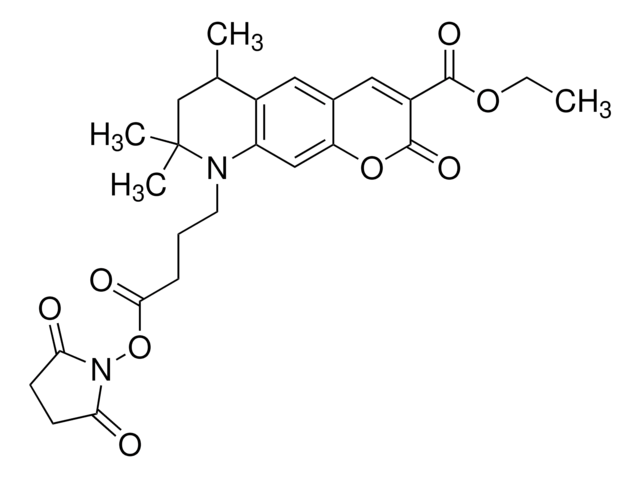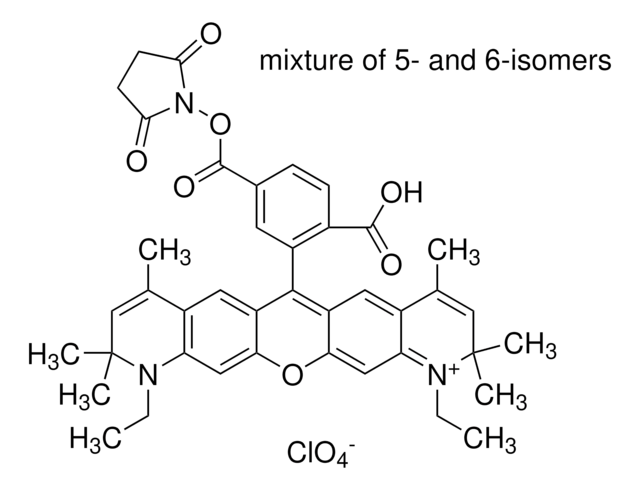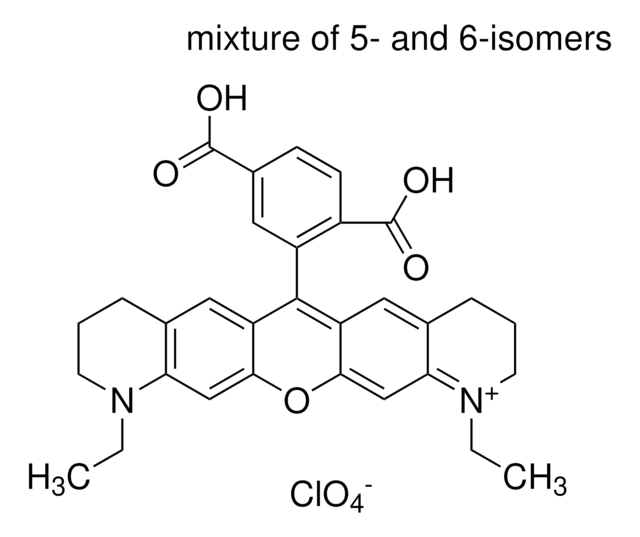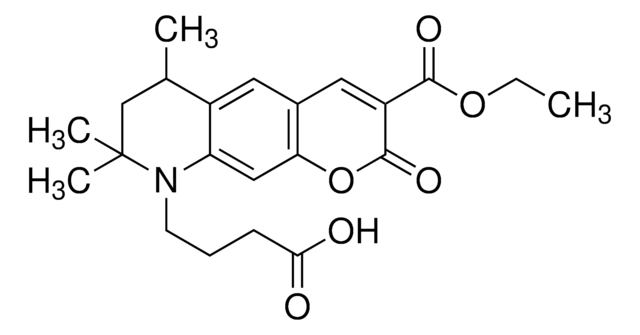72464
Atto 565 NHS ester
BioReagent, suitable for fluorescence, ≥90% (HPLC)
Sign Into View Organizational & Contract Pricing
All Photos(1)
About This Item
Empirical Formula (Hill Notation):
C35H34ClN3O11
Molecular Weight:
708.11
MDL number:
UNSPSC Code:
12352108
NACRES:
NA.32
Recommended Products
product line
BioReagent
Quality Level
Assay
≥90% (HPLC)
≥90% (degree of coupling)
form
powder
manufacturer/tradename
ATTO-TEC GmbH
suitability
suitable for fluorescence
detection method
fluorometric
storage temp.
−20°C
Looking for similar products? Visit Product Comparison Guide
General description
Atto 565 NHS ester is a commonly used amine-reactive reagent, provided by ATTO-TEC. It is widely used in protein labeling and readily reacts with compounds containing amino groups, forming a chemically stable amide bond between the dye, e.g., a protein. The optimum pH-range for NHS-ester coupling is pH 8.0 – 9.0. At this pH amino groups of proteins, i.e., the ε-amino groups of lysines are unprotonated to a degree sufficiently high for fast coupling.
Features and Benefits
- Strong absorption
- High fluorescence quantum yield
- High thermal and photo-stability
Other Notes
Fluorescence of bioconjugates; employed in fluorescence resonance energy transfer, FRET, experiments.
Legal Information
This product is for Research use only. In case of intended commercialization, please contact the IP-holder (ATTO-TEC GmbH, Germany) for licensing.
Not finding the right product?
Try our Product Selector Tool.
Storage Class Code
11 - Combustible Solids
WGK
WGK 3
Flash Point(F)
Not applicable
Flash Point(C)
Not applicable
Personal Protective Equipment
dust mask type N95 (US), Eyeshields, Gloves
Choose from one of the most recent versions:
Already Own This Product?
Find documentation for the products that you have recently purchased in the Document Library.
Customers Also Viewed
Elizabeth A Jares-Erijman et al.
Nature biotechnology, 21(11), 1387-1395 (2003-11-05)
Förster (or Fluorescence) Resonance Energy Transfer (FRET) is unique in generating fluorescence signals sensitive to molecular conformation, association, and separation in the 1-10 nm range. We introduce a revised photophysical framework for the phenomenon and provide a systematic catalog of
Benjamin Zoller et al.
Cell, 175(3), 835-847 (2018-10-20)
How transcriptional bursting relates to gene regulation is a central question that has persisted for more than a decade. Here, we measure nascent transcriptional activity in early Drosophila embryos and characterize the variability in absolute activity levels across expression boundaries.
Michael Cooper et al.
Journal of fluorescence, 14(2), 145-150 (2004-12-24)
The spectral properties of a rigidified trimethine cyanine dye, Cy3B have been characterised. This probe has excellent fluorescent properties, good water solubility and can be bioconjugated. The emission properties of this fluorophore have also been investigated upon conjugation to an
Rachael Bakker et al.
eLife, 9 (2020-06-23)
Morphogen signaling contributes to the patterned spatiotemporal expression of genes during development. One mode of regulation of signaling-responsive genes is at the level of transcription. Single-cell quantitative studies of transcription have revealed that transcription occurs intermittently, in bursts. Although the
Suman Lata et al.
Journal of the American Chemical Society, 128(7), 2365-2372 (2006-02-16)
Labeling of proteins with fluorescent dyes offers powerful means for monitoring protein interactions in vitro and in live cells. Only a few techniques for noncovalent fluorescence labeling with well-defined localization of the attached dye are currently available. Here, we present
Articles
Fluorescent Labeling of Peptides
Our team of scientists has experience in all areas of research including Life Science, Material Science, Chemical Synthesis, Chromatography, Analytical and many others.
Contact Technical Service



